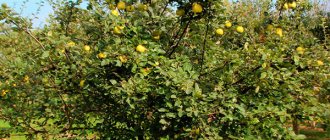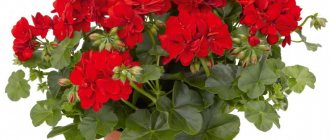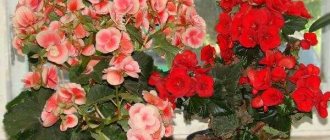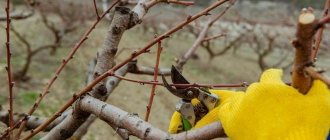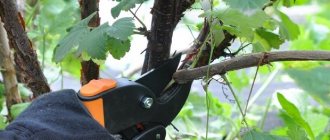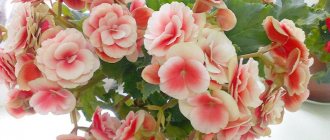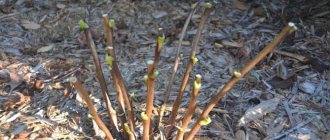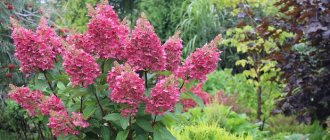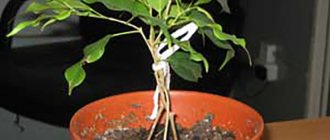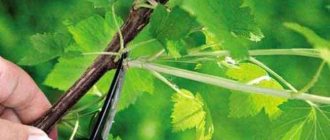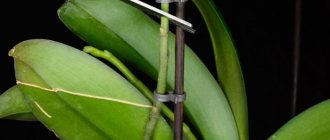Does begonia need pruning?
Left to its own devices, this plant loses its decorative value: the stem becomes elongated, the shoots become thinner, the leaves become smaller, and flowering is minimal.
Pruning is necessary to form a lush crown and improve flowering. In addition, the plant rejuvenates and takes on a well-groomed appearance.
- How to prune begonia correctly:
- We need to think about the formation of the plant at the young flower stage. When a young begonia reaches a height of about 6-7 cm, its top is cut off with a sharp knife. This is done to stimulate the development of side shoots.
- After this procedure, the number of waterings should be reduced until the plant begins to grow intensively.
- As soon as the side shoots reach a length of 10 cm, their tops are trimmed. It is important to ensure that the shortening of the stems is above the bud, which is directed towards the outside.
- This is where the formation of the young bush ends. From time to time, you can shorten elongated stems or remove dried shoots to maintain the desired crown shape.
- When should begonias be pruned?
- Flowering shoots of decorative leaf begonias should be trimmed.
- Dry, damaged leaves and shoots should be cut off to avoid flower disease.
- The young plant is pruned to give it a decorative appearance.
- Tuberous begonias need pruning for the winter.
Also learn about other subtleties of begonia care, including planting and propagation. Read about garden begonias.
Plant nutrition
Indoor begonia flower needs feeding. Flower growers recommend fertilizing with complex liquid fertilizers once every 2 weeks. It should be remembered that deciduous species require nitrogen fertilizers. In the case when the begonia is blooming, care at home requires feeding with phosphate fertilizers. There is no need to feed in winter. The exception is ever-flowering species.
Flower growers use homemade compounds to fertilize this plant.
Recipe for fertilizer with yeast:
- Take 1 g of yeast, dilute it in 1 liter of warm water.
- Add 1 teaspoon of sugar.
- Let the mixture brew for at least 3 hours.
For fertilizer, dilute the liquid with water in a ratio of 1:5. This fertilizer should be used 5 times a year.
It is useful to feed begonia with sugar. To do this, dissolve 1 teaspoon of granulated sugar in 1 liter of water. You can water with this fertilizer no more than once a month.
Used tea leaves can also be used to fertilize flowers. Dry it first and mix it with soil during replanting in the following proportion: 1 part dry tea leaves and 3 parts soil.
Wood ash is actively used in indoor floriculture.
Fertilizer recipe:
- Dilute 3 tablespoons of ash in 1 liter of water.
- Leave for a week.
You can water with this mixture once every 2 weeks. Wood ash should be added when transplanting into the soil.
In flower shops you can buy fertilizers for begonias: “Kemira Lux”, “Good Power”, “Bona Forte”, “Mister Color”. Plants should not be overfed.
Do I need to prune begonias for the winter?
Opinions on this matter are divided: some believe that pruning makes no sense, while other gardeners cut off leaves every autumn. It is imperative to trim tuberous begonias; in other species, it is still advisable to cut off the green part. This is done to provide the plant with rest during the winter. But there are also varieties that do not need pruning.
How to properly prune begonia for the winter?
With the onset of autumn, indoor tuberous begonias reduce the amount of watering. After the leaves dry out, cut off the above-ground part of the plant, leaving 1-2 cm. After this, the pot with the flower must be placed in a place for wintering. It should be a cool, dark place with a temperature no higher than +15C . A basement or loggia is suitable for this, and in apartment conditions it can be placed under a bathtub. It is necessary to water from time to time to prevent the soil from completely drying out.
When to prune begonia for the winter?
The best time for circumcision is October . This period is considered optimal. After all, in February-March the flower will “wake up” again after hibernation. And the six months that the plant will spend in a state of dormancy is quite enough to rest, gain strength and delight with its unusually beautiful flowering in the summer.
How to properly care after cutting?
After pruning, it is enough to follow the basic rules of care , as before circumcision.
Let's tell you more about them. The most favorable temperature range is from 13 to 22 degrees Celsius, but do not forget to maintain stable air humidity. The optimal level of air humidity is 60 percent. Since our begonia is a herbaceous species, the dormant state lasts from October to February.
To transfer the plant to this state, watering is reduced and wilted shoots are cut off. Some experts advise storing begonia tubers in the dark at a temperature of 10 to 12 degrees Celsius for up to two months. The best growth properties appear when the plant is in partial shade. Watering is carried out only after the top layer of soil has completely dried.
To provide the begonia with the necessary moisture, the pot should be placed on a tray with water , but so that the pot itself is not in water, or placed on wet peat.
If the humidity level is too high, the begonia will rot, so do not overdo it. On hot summer days, the air around the begonia is sprayed, but so that water does not get on the leaves. The room in which the begonia is located must be ventilated periodically, but so that the plant itself is not exposed to a draft. Transplantation is performed only in cases of extreme necessity.
In conclusion, I would like to say that pruning and pinching begonias are very important procedures that will both increase the splendor and decorativeness of the begonia and extend its life. In addition, these procedures are so simple that any novice gardener who has never even approached begonias before can perform them.
The process itself will also be useful in the future, when pinching and trimming other plants, because in fact the technology is the same.
If you find an error, please select a piece of text and press Ctrl+Enter.
Do all begonia varieties need to be pruned?
Varieties that do not need to be pruned: Royal Rex and its hybrids, ever-blooming.
Thick-trunked groups do not need to be pruned; this is done only when necessary.
In ampelous plants, only the apical stems need to be cut off to stimulate the development of lateral shoots.
Bush plants are cut, choosing a place above the bud, 5-7 cm. New young stems will develop from such “stumps”. Typically, pruning occurs in the spring, after the leaves have dropped.
Reproduction by dividing the tuber and bush
Tuberous begonia care and propagation are slightly different from other plant species. Plants that are at least 2 years old are suitable for dividing tubers. You should choose healthy planting material with 2-5 buds.
Reproduction technology:
- Divide the tuber into parts.
- Treat the cuts with wood ash.
- Plant in the soil so that only the buds remain on the surface.
- Cover the container with film.
As soon as the first leaves appear, the shelter should be removed.
Similarly, you can use the method of dividing a bush. At the beginning of spring, you need to cut the bush so that each individual element contains a bud and a sprout. Treat the cut with wood ash. Place the roots in pots with prepared soil.
Pinching begonia
If for some reason it was not possible to prune the young flower, then pinching the tops of the shoots will help restore the decorative effect.
This method allows you to achieve a decorative appearance of the bush and will help to form a crown of the chosen shape: spherical, bush, pyramidal, etc.
How to properly pinch begonia?
This procedure must be carried out in autumn or spring, that is, either before flowering or after. On the main stem you need to find the top growth point and pinch it off by 1-2 cm. After 2-3 weeks, active growth of side shoots will begin.
As soon as you have begonia in your home, you need to immediately think about its future. It is pruning and pinching at an early age that will help maintain the beautiful, spectacular, aesthetic appearance of the plant. And it will delight you with its beauty and splendor for a long time!
Rules for removing stems and shoots, when and how to do it?
Forming a crown for lush flowering
Pruning is necessary to maintain and improve the decorative appearance of plants. In fact, there are four main features when pruning begonias:
Start of trimming. This process must begin at the young flower stage. As soon as the small plant reaches a length of 6-7 centimeters, the top is cut off with scissors.
Thanks to this simple procedure, begonias stimulate the growth of side shoots.
- Reduce watering. After the first pruning, the amount of watering is reduced. This is done to increase the growth rate of begonia.
- Further pruning. The next pruning is carried out after the length of the side stems reaches 10 centimeters.
Shortening must take place above the bud, which is located on the outside of the stem. - End of trimming. Further, the shortening procedure can be carried out only to remove the most overgrown stems, or those that have dried out altogether. This procedure can also be carried out to maintain a specific shape.
- in decorative-leaved begonias, flower-bearing shoots are cut off;
- when dry or damaged leaves or shoots appear, this is done to avoid the appearance of diseases;
- in young plants to obtain decorative properties;
- pruning before winter.
In what cases is it performed?
Pruning is performed in the following situations:
When to prune plants for winter?
Flower growers often ask themselves a similar question. Be sure to prune only tuberous begonias for the winter ; all others are pruned at the request of the grower.
What will happen if this process is not carried out? In the absence of this procedure, the leaves and flowers begin to decrease in size, but the stem, on the contrary, begins to thicken, which does not look very beautiful. Therefore, this procedure is mandatory. You will find important tips for caring for begonias in winter in this article.
How and when to pinch?
The pinning procedure is carried out in the fall, or in the spring, or, to put it correctly, either before flowering or after it. Now about the process itself, which is actually very simple. On the main stem you need to find the top growing point and pinch it off 1-2 centimeters. With proper pinching, active growth of side shoots should begin within 2-3 weeks. Also, this procedure should be carried out only in cases where it is not possible to prune the begonia.
Photo
Next you will see a photo of how to prune begonia:
